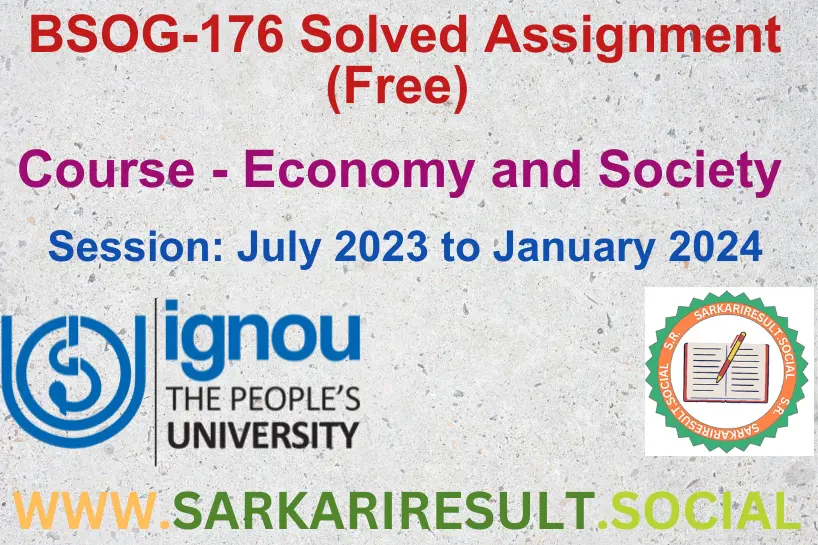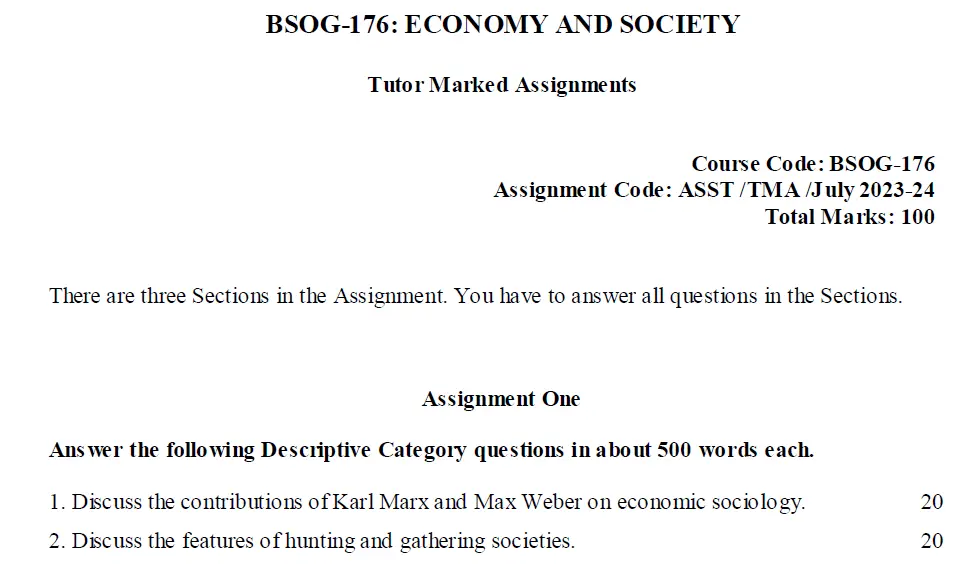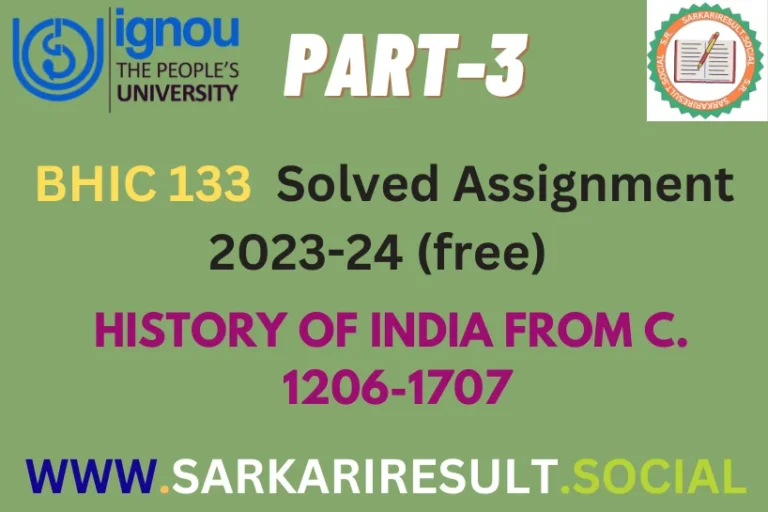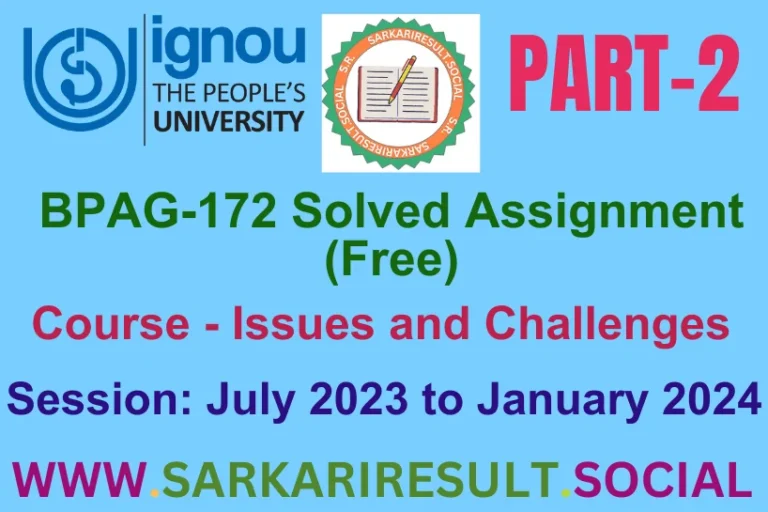Check BSOG 176 IGNOU solved assignment 2023-24 (Free)

BSOG 176 IGNOU solved assignment 2023-24 (Free)
“Get ready to excel in BSOG 176 IGNOU solved assignment 2023-24 (Free)! Our expertly crafted solved assignments for 2023-24 are here to help you succeed. The booklet includes three TMAs, carrying 30% weightage and 100 marks. Assignment A (DCQs) tests your ability to write systematic and coherent essay-type answers. Assignment B (MCQs) assesses your analysis and concise writing skills. Assignment C (SCQs) improves your ability to recall relevant information. Follow the provided instructions and submit your answers within the word limit. Success in these assignments is crucial for being eligible for the term-end examination. Enhance your writing skills and achieve academic excellence. Grab your BSOG 176 IGNOU solved assignment 2023-24 (Free) now!”
BSOG 176 Solved Part A (Questions and Answers)

Q.1 Discuss the contributions of Karl Marx and Max Weber on economic sociology.
Ans. Karl Marx and Max Weber were two influential thinkers who made significant contributions to the field of economic sociology. Their ideas have greatly shaped our understanding of how economics and society interact. Let’s explore their key contributions in a simple and concise manner.
Karl Marx, a 19th-century philosopher and economist, believed that economics played a central role in shaping societies. He introduced the concept of “class struggle,” which suggested that societies are divided into classes – the bourgeoisie (owners of production) and the proletariat (working class). Marx argued that the capitalist system, where a small elite owned the means of production, led to inequality and exploitation of the working class. He believed that economic forces drove social change and that eventually, the proletariat would rise against the bourgeoisie, leading to a classless society or communism.
Max Weber, another prominent sociologist of the same era, approached economic sociology from a different angle. He emphasized the importance of ideas, beliefs, and values in shaping economic systems. Weber introduced the concept of the “Protestant work ethic,” which suggested that the Protestant religious values, such as hard work and thriftiness, played a significant role in the development of capitalism. Weber also introduced the idea of “bureaucracy,” highlighting how rationalization and efficient organization of economic activities were becoming increasingly important in modern societies.
Both Marx and Weber recognized the influence of economics on society, but they differed in their explanations and perspectives. Marx focused on the structural inequalities inherent in the capitalist system, while Weber emphasized the cultural and psychological factors that shaped economic behavior.
In summary, Karl Marx’s contributions to economic sociology include the concept of class struggle, critique of capitalism, and the idea of communism as a solution to inequality. On the other hand, Max Weber introduced the idea of the Protestant work ethic, highlighted the importance of bureaucracy, and emphasized the role of cultural values in economic development. Both Marx and Weber have left a lasting impact on our understanding of how economics and society intersect, offering valuable insights that continue to be studied and debated by sociologists and economists today.
Q.2 Discuss the features of hunting and gathering societies.
Ans. Hunting and gathering societies, often referred to as “hunter-gatherer” societies, were the earliest forms of human societies that existed before the development of agriculture and settled communities. These societies were characterized by their unique way of life, where people relied on hunting animals and gathering plants for their sustenance. Let’s explore the key features of hunting and gathering societies in a simple and concise manner.
1. **Nomadic Lifestyle:** Hunter-gatherers were nomadic, meaning they didn’t have permanent homes. They followed the movement of animals and the seasonal availability of plants for food. This constant movement allowed them to find new sources of nourishment and avoid depleting local resources.
2. **Small, Kinship-Based Groups:** Hunter-gatherer societies were organized into small groups, often consisting of extended families or clans. These groups shared strong kinship ties and worked together for survival. Cooperation was essential for hunting, gathering, and raising children.
3. **Limited Division of Labor:** In these societies, there was a minimal division of labor. Men typically engaged in hunting, using tools like spears and traps, while women gathered edible plants, fruits, nuts, and roots. Both genders played vital roles in providing for the group.
4. **Simple Technology and Tools:** Hunter-gatherers used basic tools made from stone, bone, and wood. These tools were essential for activities such as hunting, preparing food, and creating clothing and shelter. Their resourcefulness allowed them to adapt to various environments.
5. **Egalitarian Social Structure:** Hunter-gatherer societies generally had more egalitarian social structures compared to later agricultural societies. Decisions were often made collectively, and there was less hierarchy and inequality. Since resources were shared, there was less emphasis on individual ownership.
6. **Oral Tradition:** Without a writing system, hunter-gatherer societies relied on oral tradition to pass down knowledge, stories, and cultural practices from one generation to the next. This helped maintain their cultural identity and shared history.
7. **Close Connection to Nature:** Hunter-gatherers had an intimate relationship with their natural environment. They relied on their deep knowledge of local ecosystems to find food, medicine, and other resources, and this knowledge was transmitted orally.
8. **Limited Population Size:** Due to the nature of hunting and gathering, the population density of these societies was relatively low. They depended on the availability of food sources in a specific area, which naturally limited the number of people that could be supported.
9. **Symbiotic Relationship with the Environment:** Hunter-gatherers practiced a sustainable lifestyle by adapting to and working with their surroundings. They moved from one region to another as resources became scarce, allowing ecosystems to regenerate.
In conclusion, hunting and gathering societies were characterized by a nomadic lifestyle, kinship-based groups, simple tools, egalitarian social structures, and a deep connection to nature. These early societies played a crucial role in shaping human history, as they laid the foundation for the development of more complex forms of societies, such as agricultural communities and civilizations.
BSOG 176 Solved Part B (Questions and Answers)

Q.3 Discuss the concept of money.
Ans. Money is a vital and familiar concept that makes trading and buying things much easier. It serves as a common medium of exchange, allowing people to trade goods and services without having to barter directly. Instead of trading one item for another, people use money as a way to represent value.
Imagine if you wanted to buy a toy from a friend, but all you had was a book. If your friend didn’t want a book, you wouldn’t be able to get the toy. That’s where money comes in. Money is like a special token that everyone agrees has value. It’s accepted by everyone, so you can use it to buy toys, clothes, food, or anything else you need.
Money also has three important functions:
1. **Medium of Exchange:** Money allows people to easily trade goods and services. Instead of finding someone who wants what you have and has what you want, you can just use money to buy or sell.
2. **Unit of Account:** Money acts as a standard measure of value. It helps you compare the prices of different things and decide what you can afford to buy.
3. **Store of Value:** Money can be saved for future use. You can keep your money safe and use it whenever you need to buy something later.
Different types of money have been used throughout history, such as coins made of metal and paper bills. Nowadays, we also have digital money that we use for online shopping or transferring funds electronically.
Overall, money simplifies trading, helps us compare prices, and allows us to save for the future. It’s like a special tool that makes our lives easier by helping us buy, sell, and manage our resources.
Q.4 Explain the concept of ‘forces of production’.
Ans. The concept of ‘forces of production’ is a way to describe the tools, technology, and resources that people use to make things. It’s like all the stuff we need to create the items we use every day, like clothes, toys, and even food.
Think of it as a big puzzle. The pieces of the puzzle are things like machines, tools, land, and even the knowledge and skills that people have. When all these pieces come together, they help us produce goods and provide services. For example, in making a toy, the machines that mold plastic, the tools to paint it, and the people who know how to assemble it are all part of the forces of production.
The idea is that these forces of production interact with another concept called ‘relations of production.’ This means how people work together to create things and how they share the results. For instance, some people own the machines and factories, while others work there. How these groups interact and who gets what from the production process is a big part of understanding how societies function.
So, to sum it up, ‘forces of production’ is like the building blocks we use to create things, and it’s an important idea to understand how economies and societies work. It helps us see how different parts come together to make the world around us.
Q.5 Describe the characteristics of transhumant pastoralism.
Ans. Transhumant pastoralism is a way of life practiced by certain groups of people, often in places with harsh environments, where they move their livestock (animals like sheep, goats, and cattle) from one place to another in search of food and water. This type of lifestyle has specific characteristics that help these people adapt to their surroundings.
1. **Seasonal Movement:** Transhumant pastoralists don’t stay in one place all year. They move their animals between different areas based on the changing seasons. In the warmer months, they might go to higher pastures where there’s more grass, and in the colder months, they may move to lower areas for milder weather.
2. **Livestock Dependence:** Their lives are closely tied to their animals. They rely on them for things like milk, meat, wool, and leather. The animals also play a role in their culture and traditions.
3. **Traditional Knowledge:** Transhumant pastoralists have a deep understanding of the land, weather patterns, and the needs of their animals. This knowledge is often passed down through generations and helps them make informed decisions about when and where to move.
4. **Portable Shelter:** Since they move frequently, their homes are often portable, like tents or huts. These shelters are designed to be easy to set up and take down as they move.
5. **Self-Sufficiency:** They have to be self-sufficient because they’re often far from towns and markets. They produce most of what they need, from food to tools and clothing.
6. **Limited Technology:** Transhumant pastoralists often use simple tools and technology that they can carry with them. This helps them adapt to different environments without relying on complex machinery.
7. **Close-Knit Communities:** Because they move together, these groups tend to have strong communities. They help each other with tasks like herding animals, setting up camp, and sharing resources.
8. **Connection to Nature:** They have a strong connection to the natural world, understanding the importance of preserving the land and resources they rely on.
In conclusion, transhumant pastoralism is a unique way of life where people move their livestock between different areas to survive in challenging environments. This lifestyle requires a deep understanding of nature, a strong sense of community, and the ability to adapt to changing conditions.
BSOG 176 Solved Part C (Questions and Answers)

Q.6 What is feudal mode of production?
Ans. Feudal mode of production was a way of organizing society in medieval times. Lords owned land and protected peasants, who worked the land and gave a portion of their crops in return. This system involved loyalty and obligations, where peasants served the lords in exchange for safety. It was based on social classes and land ownership, with little mobility. Lords had power, peasants had land and protection, and a sense of duty tied them together. This system gradually changed as societies evolved, leading to new ways of organizing economies and societies.
Q.7 Who is a peasant?
Ans. A peasant is a person who works on the land, usually farming crops or raising animals. They are often part of a rural community and are essential for producing food. Peasants may own small plots of land or work for larger landowners. They live off the land and rely on farming for their livelihood. Peasants have traditionally been an important part of societies, contributing to the economy by growing food and sustaining local communities.
Q.8 What do you mean by ‘development from bottom’?
Ans. ‘Development from bottom’ means starting improvements and changes at the local level, with the people who live there. Instead of top-down decisions coming from higher authorities, communities themselves initiate and drive progress. This approach focuses on the needs and ideas of local people, empowering them to make decisions that benefit their area. It’s like building a strong foundation for growth by involving and listening to the individuals and communities who are directly affected.
Q.9 What is socialism?
Ans. Socialism is an idea where resources and wealth are shared more equally among people in a society. Instead of a few individuals owning most things, socialism suggests that important industries and services should be owned and managed collectively by the community. The goal is to reduce inequalities, provide essential needs like education and healthcare for everyone, and make sure no one is extremely rich or extremely poor. While socialism aims to create a fairer society, different countries interpret and practice it in various ways, with some combining socialist ideas with other forms of government.
Q.10 What is mixed capitalism?
Ans. Mixed capitalism is an economic system that blends elements of both capitalism and government intervention. In this system, some industries and businesses are privately owned and operated for profit, while others are owned or regulated by the government to ensure fairness, safety, and public well-being. This mix aims to combine the strengths of both approaches: the innovation and efficiency of capitalism with the protection and social support of government involvement. It’s like finding a balance between letting businesses compete and making sure everyone has equal opportunities and essential services.







